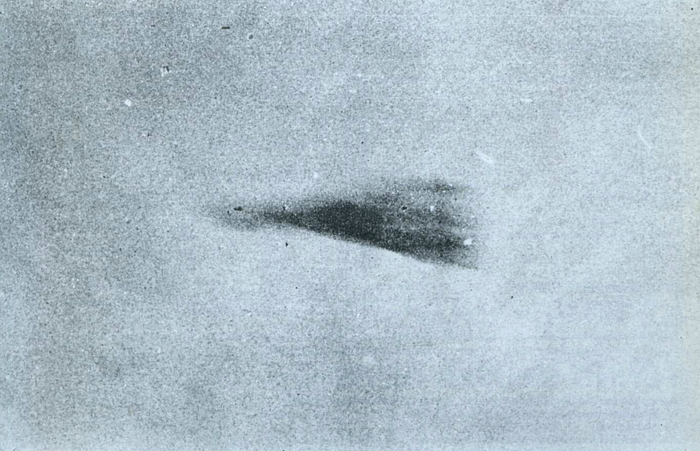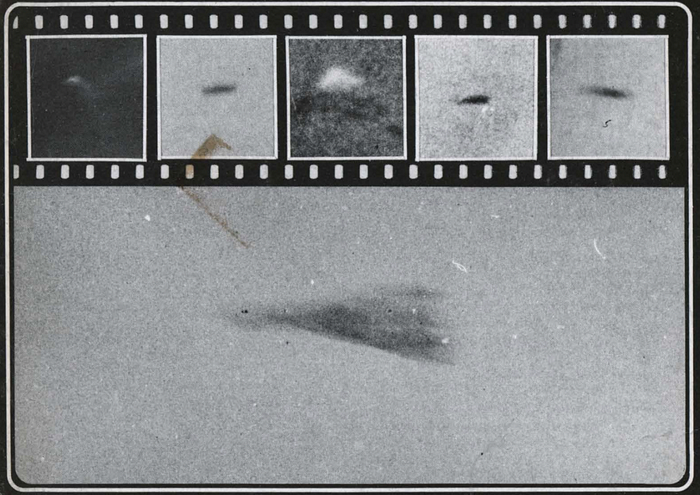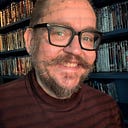He Was a Teenage UFO Photographer: The Most Convincing Photographic Evidence Ever?

Hidden in the history of Swedish — and international — UFO observations, it’s possible to find one of the more anonymous incidents ever, at least when looking at it from a media perspective. It caused some headlines at the time, mostly in local newspapers, and later got some extensive coverage in Flying Saucer Review, issue 6, 1976. However, it was in GICOFF-Information, the ambitious member magazine for Göteborgs Informationscenter för Oidentifierade Flygande Föremål (“Gothenburg’s Information Center for Unidentified Flying Objects”), those with an interest in UFOs first had a chance to read about the case.
GICOFF was known for their meticulous investigations on location and careful analyses of photographic evidence conducted by Gunnar J:son Bunker. Bunker a professional photographer of album covers — and with a short, yet popular, stint as a humorous recording artist himself. Most of the photos he examined he debunked, so maybe his name should have been DeBunker instead of Bunker? Not all of them though, because in 1973 a 14 year old boy managed to snap a series of photographs which still, up until this day, are unexplained.

Penttäjä in Övertorneå municipality, not far from the Finnish border, is a village so small it’s not fair to call it a village. At the time it consisted of seven houses, and only five of them inhabited, a road and not much more. Well, except the miles of forest surrounding it. It’s placed between two small lakes, Kivijärvi and Penttäjänjärvi, and there the only teenager in the village and his family lived. Åke Lejon had to take the bus over one hour every day to school in Övertorneå, so it’s not surprising the young man had to spend his days exploring his surroundings and the universe instead of hanging out with friends.

It was during the morning of November 11, 1973, and Åke went out to capture the beautiful landscape with a simple Instamatic camera he had borrowed from his niece. While pulling his sister’s one year old son Jörgen behind him on a sledge, he walked 300 meters down along the road leading to the lake. He stopped at a small hill. A perfect place for photos.
While looking out at the beautiful scenery around him he noticed something up in the relatively clear sky (most of the clouds were on a level of 6000 meters, and a few around 2500–3000 meters up), a balloon-like object slowly moving up in the air, maybe one or two kilometers from him. During a couple of minutes he studied the strange sight, but came to the conclusion it must be some kind of balloon. Then something happened. The “balloon” changed shape. Åke described it as a loaf of bread, but with more pronounced edges. It had a dark spot on top and continued to turn and become flatter. The rest of the body had a steel gray color and — it seemed — a slight yellow glow underneath it. It turned slightly forward with its nose down and started to accelerate and then up into the clouds. The apparent change in shape could have been an illusion caused by the craft when it turned from the side to its final position. During the acceleration the whole incident turned even weirder, as a triangular shaped object disengaged from the loaf-UFO and flew, much faster, in an arched motion underneath the loaf , and in the opposite direction. It was in a silver-white color and it felt like it was glowing, but that could of course be a reflection from the daylight.



Åke, because he was a smart kid, took four photos for the event unfolding in front of him, and in total seven photos were taken during the whole incident, the first one being a landscape photo of the Kivijärvi lake in front of his family’s house, where it’s possible to compare the trajectory of the objects in relation to the landscape behind.


Well, another exciting day in Penttäjä, and the routine was soon back in business. Åke kept quiet about the incident, maybe not realizing the uniqueness of it. His parents suggested it must have been some kind of military aircraft. One day Åke was visited by a local newspaper, Norrländska Socialdemokraten and journalist Arne Bodin, because of an impressive find of copper. He showed the photos to the newspaper’s photographer, Lennart Norman, who instantly felt they were very interesting. Åke gave him four developed copies to Lennart and kept the negatives.

The visit resulted in several articles about Åke’s find of copper ash (he was awarded 7500 Swedish kronor for it by the Norrlandsfonden Foundation, a big amount of money at the time) including the sensational news about the observation. “IS THIS A FLYING SAUCER?”, proclaimed the headlines. The military showed a keen interest in Åke’s observation and did their own analysis of them, but concluded — with a clear disinterest from their official UFO investigator, Tage Eriksson: “It’s impossible to say what they represent, but it could be a broken weather balloon on its way to Earth”.

At the Swedish National Defence Research Institute, where Tage Eriksson was an associate professor, they found nothing fishy with the photos, but also felt that they had no economy to spend on a further investigation. However, Gunnar J:son Bunker, GICOFF’s own photo expert, was very impressed. “Let me first say that these photos are sensational”, he wrote in issue 2 of GICOFF-Information, 1974, and added that he found no sign of either reflections, manipulation or anything else odd with the photographs. He claimed that they were SO good they could have been taken by himself, this even if they were taken with a cheap Instamatic and the fact that Åke was nearsighted and didn’t have his glasses on that day. There is some confusion in which order the photos were taken, but the result is still impressive. Something is definitively caught on them, and it’s still unexplained — and I think it’s pretty clear it’s not a weather balloon. Even if the surviving copies, only taken from printed material, are blurry at best, they’re still clear enough to see that it’s not any other kind of external artifacts.

The witness himself estimated the objects to be approximately 25 meters in length, but that if the distance of one to two kilometers was correct. The investigators from GICOFF later estimated it to be between 25 and 40 meters in length. Everyone who looked into the case and communicated with Åke said he was someone to be trusted. As mentioned above, a smart kid.

The negatives are now lost, and are not included GICOFF’s, material at Archives for the Unexplained in Norrköping. Imagine if they could be found and what today’s technology could do with them? The thought is staggering. What about the young photographer? Always thirsty for knowledge, Åke got his dream job the year after, in 1974, when he began a summer job at the Geological Survey of Sweden, a job he returned to each summer until 1983. He studied to be a chemist and is today a successful business owner. “I still have no idea what it was”, he told Clas Svahn in a later interview, “but when the war in Iraq started and I saw the American stealth planes, I thought they were similar to what I saw”.
I’ve always said that the best way to experience something out of the ordinary is in a still environment, far from the noise of civilization. It’s like the mind — and eyes — are extra open to what can suddenly differ from the reality around. Maybe one day those negatives will show up, and maybe that’s the day we will finally know what was flying over Penttäjä on November 11, 1973.
Fred Andersson is a Swedish story producer and writer with over twenty years of experience in commercial television and the author of three books. He lives in Märsta, outside Stockholm, with his photographer husband Grzegorz and two overly active cats. Join him on Twitter and Instagram.
Sources.
“Ung svensk forskare tog unik bildserie av UFOs” (GICOFF-Information, issue 2, 1974)
Photo of Åke Lejon, NSD 15/1, 1974, used by kind permission.
“Young Swedish scientist’s unique series of UFO photos” (Sven-Olof Fredrikson, issue 6, 1976)
UFO: Spökraketer, Ljusglober och Utomjordingar (Clas Svahn, p. 160–167, Semic, 2014)
“14-åring i ödebygd: Intresse för sten gav unikt malmfynd” (Lennart Lundegårdh, SVD, 29/11, 1973)
Material from NSD and FSR used with kind permission. Thank you! ❤️
